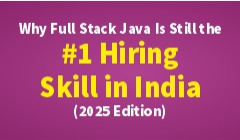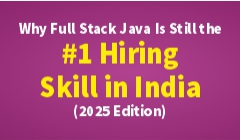
Understand what Full Stack Java is, the key developer roles, skills to master, and career scope in India’s IT industry for 2025 and beyond.
If you’ve ever wondered “What exactly is Full Stack Java, and why is it in such high demand?” — you’re not alone.
As of 2025, Java powers over 3 billion devices and remains a foundation of enterprise software worldwide. From banking to e-commerce, Full Stack Java developers are the architects behind secure, scalable, and modern web applications — and they’re among the most hired roles in India.
India’s IT sector is experiencing a hiring boom. Let’s look at the 2025 snapshot:
NASSCOM 2025 Report: 1.4 million new IT jobs to be created; Java Full Stack remains in the top 3 hiring skills.
LinkedIn India (Oct 2025): 120,000+ active listings for Full Stack Java developers.
Hyderabad, Bangalore, Pune — major hubs for Java-based product and service companies.
Average starting salary: ₹4.8–6.8 LPA for trained freshers; ₹10–18 LPA mid-career.
Recruiters repeatedly note that Java’s versatility + full-stack integration skills make candidates immediately deployable.
A Full Stack Java Developer is an engineer who can build both front-end and back-end components of an application — using Java technologies across every layer of development.
Think of it as being the “all-rounder” of software teams:
Front-End (Client-Side): Builds responsive UIs using React, Angular, or JSP.
Back-End (Server-Side): Handles business logic using Java, Spring Boot, Hibernate.
Database Layer: Manages data storage with SQL / MySQL / MongoDB.
DevOps/Deployment: Uses Git, Maven, Docker, AWS for versioning & hosting.
So instead of just coding one part, you create an entire functioning web system — from user interface to database connectivity.
Designing application architecture using Spring Boot or Microservices.
Developing front-end logic and integrating REST APIs.
Managing databases and writing optimized queries.
Testing & debugging across the application stack.
Deploying apps on cloud platforms (AWS, Azure, GCP).
Collaborating with UI/UX designers and DevOps teams.
“Hiring Full Stack Java Developer with experience in Spring Boot + React + AWS. Must understand end-to-end project lifecycle.” — Indeed India Job Post
Foundation for writing clean, modular, and reusable code.
Simplifies backend development and scales enterprise applications.
React, Angular, or JSP for building interactive web interfaces.
MySQL, PostgreSQL, or MongoDB for CRUD operations and performance tuning.
Basics of Docker, GitHub, Jenkins, AWS for continuous integration & deployment.
Git for collaboration and version tracking.
Essential for real-world project success.
Global Scope: Java developers from India are in demand across US, UK, and Middle-East markets due to their strong backend expertise.
“When a candidate understands the complete lifecycle — from database to UI — onboarding is faster, and productivity is instant.”
— HR, Capgemini India (2025)
Java’s maturity, performance, and stability give organizations confidence. A Full Stack Java developer can maintain legacy systems while integrating modern frameworks, making them a long-term asset.
NareshIT’s Full Stack Java course bridges the gap between theory and job-readiness:
Real-Time Curriculum: Built with input from 100+ hiring partners.
Project Portfolio: 3–4 live applications deployed on cloud.
Mentorship: One-on-one trainer guidance & technical doubt support.
Q1: What exactly is Full Stack Java?
Ans: It means developing both front-end and back-end applications using Java technologies like Spring Boot and React.
Q2: Is Full Stack Java good for freshers in 2025?
Ans: Yes! Recruiters rank it among the most employable skills due to continuous enterprise demand.
Q3: Do I need prior programming knowledge?
Ans: No. NareshIT’s course starts from core Java basics and builds up to deployment.
Q4: What is the average salary for a Full Stack Java fresher?
Ans: Between ₹4.5 – 6.8 LPA, with potential to reach ₹15 LPA in 3–5 years.
Q5: What projects will I build in training?
Ans: E-commerce system, HR portal, and a REST API app deployed on AWS.

Freshers in India trust Full Stack Java for IT jobs in 2025. Discover 10 reasons why this course offers strong placement, salaries, and career growth.
Every fresher dreams of landing their first IT job quickly and securely. But with so many technologies trending—Python, AI, cloud—it’s confusing where to begin. Recruiters still say Java dominates IT hiring in India, especially for freshers starting their career. That’s why thousands of students choose NareshIT’s Full Stack Java course a career path that balances job security, global demand, and fast placement opportunities.
Before diving into the top 10 reasons, here’s the demand snapshot (2025):
NASSCOM (2025): India to create 1.4M IT jobs by 2025; Full Stack Java ranks in top 3 skills.
Hyderabad/Bangalore job portals (Oct 2025): Over 120,000 Java job postings.
Average fresher salary in India (Java, 2025): ₹4.5 – ₹6.8 LPA.
Enterprise trust: 70% of Fortune 500 companies rely on Java-based systems.
Recruiters consistently list Java + Full Stack as a priority skill for freshers. Hiring managers prefer multi-skilled candidates who can code, design, and deploy.
Java is easier to start with compared to low-level languages. Freshers get step-by-step exposure from core Java → Spring Boot → UI frameworks → deployment.
India contributes nearly 30% of global Java workforce. Freshers from Hyderabad & Bangalore get remote + onsite projects.
Freshers trained in Full Stack Java land jobs at ₹4.5–6.8 LPA, higher than many other entry-level IT roles.
Banks, telecoms, fintechs, and e-commerce companies trust Java for large-scale apps, ensuring steady demand for Java developers.
“We hire freshers with Full Stack Java because they can manage projects end-to-end, not just write code.” – HR Manager, Deloitte India.
NareshIT’s Full Stack Java course ensures freshers graduate with 3–4 real-world projects (e.g., e-commerce cart, employee management system, HR portal).
Thousands of NareshIT alumni have transitioned from job seekers → offer letters in 90 days. Example: Priya (Hyderabad, 2025) landed ₹7.2 LPA as a fresher.
Full Stack Java opens growth paths: Backend Developer → Full Stack → Cloud/Microservices → Solution Architect. Mid-level salaries: ₹10–18 LPA.
Unlike short-term fads, Java has been stable for 25+ years. Recruiters say: “Freshers with Java skills never go out of demand.”
Why do freshers trust NareshIT for Full Stack Java careers?
Humanized Syllabus: Designed with 100+ hiring partners.
Live Projects: Recruiter-tested, portfolio-ready.
Mentor Support: Labs, 24x7 doubt clearing.
|
Career Stage |
Skills Learned |
Avg Salary (2025) |
|
Fresher (0–2 yrs) |
Core Java, Spring Boot basics, SQL, 2 projects |
₹4.5–6.8 LPA |
|
Early Career (3–5 yrs) |
Full stack, CI/CD, Cloud basics |
₹10–14 LPA |
|
Mid-Senior (5+ yrs) |
Microservices, Architect roles |
₹18–25+ LPA |
Q1: Why should freshers choose Full Stack Java over Python or AI?
Ans: Java offers stable jobs + higher fresher demand compared to emerging stacks.
Q2: How long does it take to become job-ready with NareshIT?
Ans: 6 months of structured training + placement batch = job-ready in 90 days.
Q3: Do freshers need prior coding skills?
Ans: No. The course starts from basics with mentor guidance.
Q4: Which companies hire NareshIT Full Stack Java students?
Ans: Infosys, TCS, Deloitte, Tech Mahindra, Capgemini, and 100+ partners.
Q5: What projects will I work on?
Ans: E-commerce system, HR portal, employee management app, and recruiter-tested assignments.

Full Stack Java dominates IT hiring in India 2025. Discover salaries, demand, recruiter insights & why NareshIT training ensures job-ready success.
India is projected to create 1.4 million new IT jobs by 2025 (NASSCOM). Yet recruiters say 7 out of 10 freshers struggle to clear interviews. What makes the difference? Skills that bridge coding + deployment + projects. And in 2025, Full Stack Java remains the #1 hiring skill recruiters bet on.
The Indian IT industry is still powered by Java ecosystems. Here’s why:
70% of Fortune 500 companies continue to run mission-critical apps on Java.
India contributes 30% of the global Java developer workforce, with Hyderabad, Bangalore, and Pune as top hubs.
Average fresher salaries for Java developers in India (2025): ₹4.5–6.8 LPA; mid-career salaries: ₹10–18 LPA.
NASSCOM (2025): Full Stack Java is among the Top 3 in-demand IT roles.
Job boards (Indeed/LinkedIn India, 2025): Over 120,000 active Full Stack Java postings.
Takeaway: Recruiters aren’t just asking for coding. They want job-ready Full Stack developers who can build and deploy end-to-end solutions.
So many technologies trend—Python, Node.js, Go—but Java keeps leading. Here’s why recruiters trust it:
Mature Ecosystem: Spring Boot + Hibernate + React/Angular create scalable apps trusted by banks, fintech, and e-commerce.
Enterprise Dependence: 7 out of 10 BFSI and telecom firms still use Java for secure and scalable applications.
Recruiter Quote (NareshIT Hiring Partner, Hyderabad, 2025):
“We prefer Full Stack Java developers because they can manage both legacy systems and modern apps. It’s a win-win for employers.”
Global Recognition: Indian Java developers are sought after by US, UK, and Middle East firms outsourcing projects.
Result: Full Stack Java is not just relevant—it’s indispensable in 2025.
A fresher who knows only Java coding = limited opportunities.
A Full Stack Java developer = multiple opportunities across front-end, back-end, and deployment.
Front-End: Angular/React → Attractive UI.
Back-End: Java + Spring Boot → Secure API services.
Database: SQL/NoSQL → Scalable data.
Deployment: Docker + AWS → Cloud-native readiness.
This integration = faster hiring because companies prefer one multi-skilled developer over two narrow specialists.
|
Stage |
Skills Expected |
Average Salary India (2025) |
|
Entry-Level (0–2 yrs) |
Java + Spring Boot basics + one project |
₹4.5 – ₹6.8 LPA |
|
Mid-Level (3–6 yrs) |
Full-stack deployment, cloud, CI/CD |
₹10 – ₹18 LPA |
|
Senior-Level (7+ yrs) |
Architecting scalable enterprise apps |
₹25 – ₹40 LPA |
ROI Insight: A fresher investing in NareshIT’s 6-month Full Stack Java training can land ₹7.2 LPA offers within 90 days of placement support.
Recruiters care less about marks and more about real projects.
E-Commerce Cart System: Java + React + SQL with real-time payment gateway.
Employee Management Portal: Spring Boot + Angular + REST APIs for HR workflows.
Job Portal (NareshIT Alumni Project): Cloud-hosted application deployed on AWS + Docker, helped students land jobs at TCS & Infosys.
Recruiter Quote:
“When a fresher shows they’ve deployed a working Java app on the cloud, it’s a green flag for hiring.”
What makes NareshIT India’s #1 Full Stack Java training provider?
Syllabus: Designed with 100+ hiring partners (includes Spring Boot, Microservices, React, AWS).
Mentor Support: Dedicated labs + doubt-clearing mentors.
Projects: Real-world recruiter-tested projects.
Placements: 25 years of legacy, 100+ placement partners, alumni in Infosys, Deloitte, Capgemini, Accenture.
Alumni Win (Priya, Hyderabad, 2025): From fresher to ₹7.2 LPA at Tech Mahindra within 90 days.
Q1: Is Full Stack Java still relevant in 2025?
Ans: Yes, Java remains the backbone of enterprise IT. Recruiters confirm Full Stack Java is the top hiring skill in India.
Q2: What is the average salary for a Full Stack Java fresher in India (2025)?
Ans: Freshers earn ₹4.5–6.8 LPA, with fast growth to ₹10–18 LPA mid-career.
Q3: Do I need to know coding before joining NareshIT’s Full Stack Java course?
Ans: No. Our course is structured from basics to advanced, with mentor support.
Q4: How long will it take to become job-ready?
Ans: NareshIT’s 6-month program + placement batch prepares students for interviews within 90 days of completion.
Q5: Does NareshIT provide placement support?
Ans: Yes. With 100+ hiring partners, NareshIT provides dedicated placement drives and mock interviews.